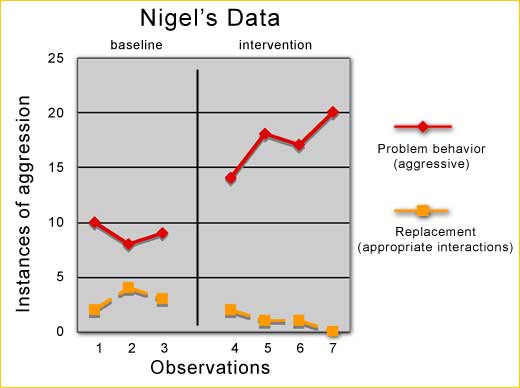Functional Behavioral Assessment: Identifying the Reasons for Problem Behavior and Developing a Behavior Plan
Assessment
Take some time now to answer the following questions. Please note that the IRIS Center does not collect your Assessment responses. If this is a course assignment, you should turn them in to your professor using whatever method he or she requires. If you have trouble answering any of the questions, go back and review the Perspectives & Resources pages in this module.
- Give a school-based example of two of the following: positive reinforcement, negative reinforcement, punishment, or extinction.
- Discuss at least two benefits of conducting an FBA to address problem behaviors.
- Watch the video below and fill out the ABC analysis form on Kira, the girl in the white shirt. What do you think is the function of Kira’s behavior?
Transcript: Assessment
Teacher: All right, so today we’re going to talk about stories. What makes a good story?
Kira: [Whistles]
Teacher: Kira, that’s enough. Thank you.
Teacher: What makes a good story? Yes, Kira?
Kira: Um, one that has a girl that has blonde hair and blue eyes.
Teacher: Okay.
Kira: Just like me.
Teacher: Anybody? Okay, yes.
Student: Maybe it has some action in it and maybe, like, action.
Teacher: Okay. And do stories have to be true?
Students: No. No.
Teacher: No. And how can you start a story? Yes, Kira.
Kira: With a “The End.”
Teacher: Okay. Thank you. That’s enough. Yes?
Student: With maybe with someone getting in trouble.
Teacher: Someone’s getting in trouble.
 Nigel’s problem behavior includes cursing, making derogatory comments toward other students, yelling, spitting, and shoving chairs. Which direct observation method would you use to collect data on Nigel’s problem behaviors? Explain your answer.
Nigel’s problem behavior includes cursing, making derogatory comments toward other students, yelling, spitting, and shoving chairs. Which direct observation method would you use to collect data on Nigel’s problem behaviors? Explain your answer.- Look at the matrix below for Nigel. Use this information to determine a possible function of the behavior and to develop a hypothesis statement.
| Functions of Behavior | ||||||||||||||
|---|---|---|---|---|---|---|---|---|---|---|---|---|---|---|
| Obtain | Avoid | |||||||||||||
|
||||||||||||||
|
||||||||||||||
- Look at the graph below. The objective of the function-based intervention was to reduce the instances of Nigel’s problem behaviors (i.e., cursing, making derogatory comments toward other students, yelling, spitting, shoving chairs) during a twenty-minute small-group activity. Is the intervention successful? If you were the teacher, would you keep, modify, or discontinue the intervention? Explain your answers.

Nigel’s Data: This line plot graph shows Nigel’s Data. The x-axis is labeled “Observations”; observations 1 through 7 are labeled on the axis. The y-axis is labeled “Instances of Aggression”; 0 to 25 is labeled in 5-number intervals. The graph is divided into two columns, after the 3rd observation. The left column of the graph is labeled “baseline” and the right column of the graph is labeled “intervention.” The first graph of the baseline column is red and labeled “Problem behavior (aggression)” in the key to the right of the graph. This graph has three plot points corresponding with the three observations. The points are at 10, 8, and 9. The second graph of the baseline column is yellow and is labeled “Replacement (appropriate interactions).” This graph has three plot points corresponding with the three observations. The points are 1, 4, and 3. The first graph of the intervention column is red and labeled “Problem behavior (aggressive)” in the key to the right of the graph. This graph has four plot points corresponding with the four observations. The points are at 14, 17, 16, and 20. The second graph of the intervention column is yellow and labeled “Replacement (appropriate interactions).” This graph has four plot points corresponding with the four observations. The points are at 2, 1, 1, and 0.
- Discuss why it is important to evaluate implementation fidelity. Be sure to explain the role of social validity ratings.